Albert Adam - pdf. portfolio 2012

Albert, Ádám: The Bauxite Crisis, installation, 2014
-------------------------------------------------

Albert, Ádám: descriptio, installation, 2013
descriptio (PDF)
Descriptio is a total installation occupying the two basement rooms of FUGA, Budapes Architectur Centrum. It is a complex and intricately interwoven assemblage of disparate elements or better to say units, which occupy descrete parts of the gallery space keeping a bit of a distance, yet resonate with each other. The arrangement of the separate object groups invite the visitor into an active interpretative role, in which the parts become co-referential. In this process, an extensive time-span opens up in order to complet the viewer into a critical reconsideration of the historical basis of taxonomical thinking and thereby its debt to early forms of logistics become visible.
Albert takes up the imaginary he started with his previous work Never take atrip alone, in wich he “inserted” the study rooms of two influential, intellectual figures of German histrory, Johann Wolfgang vin Goethe and Alexander von Humboldt, into a perspective box (peep show) modell on its 17th century predecessor. Like the previous work, Descriptio reflects on a wide scale of cultural-intellectual transmission (that is, the means and modes of knowledge production) through time, placing them into an imaginary aesthetic sphere.
On entering the gallery space, the first impression is the dominance of grey, white, and black. The gallery’s pure white enhances this effect of under-tint colours. The first set of ojects one is confronted with are three monochrome globe forms, carefully placed on a table, painted black, white and grey. It is a symbolic erasure of continents and oceans, the traces of how the map would represent the earth, where one can spot a home land. There is only a word on the fourth globe: Heimat, in gothic German characters. There is no stopping from here, the installation starts to work on the viewer and the different aspects of colonializing discoveries and the means and effects reveal themselves, posing the question: what counts as home today, and how was this home constructed? On the left wall there is a convex Dutch mirror plavced opposite a file cabinet condensing the whole enterior in its reflection.In the far right corner a group of twenty bell-glasses, all empty, reinforcing the emptyness of the file cabinet. The critique os systematic knowledge production comes to its peak with the blank light projected from a still-projector (a reference to the imaginary projections of laterna magicas) to the wall near the entrance. One the two walls opposite to each otherb two huge ink drawings add up to the concept of the criticism of the birth of global logisctics and the systematic colonialization and classification of the world: a crane from a cargo harbour (an inspiration from Frankfurt am Main), and a cargo opposite to it , the theme of these drawings are futher enhanced by the four small engravings on the right wall depicting slighty altered maps and ships.
The smaller room gives place to two set of plants under eight laboratory-like magnifying glasses, the scene fits into the context os taxonomical enquiry, but the aesthetic dimension of the objects and their arrangment is also of importance: the plamts (sedum) are elementay structures. On the neighbouring two walls two images of trees are projected, contrastin the blankness od the other room’s still projector. In Albert’s installation the display also becomes part of the suject matter.
The installation shows that - as a mode of traversing throuht time- the juxtaposition of the technikal and scientific devices of distant epochs, those once of major importance (like the filing system, cartography, botany etc.) can be presented by contenporary modes and approaches of visualisaiton. The work however points beyond the invocation of the past. It directs attention to how the framework of contextualization can switch perspective. Albert’s aspiration ,s to understand and critique the mechanism taxonomic siystem, classification, archiving, in other words, the construction of sytematic knowledge through the realm of the aesthetic. (Varga,Tünde)
-------------------------------------------------
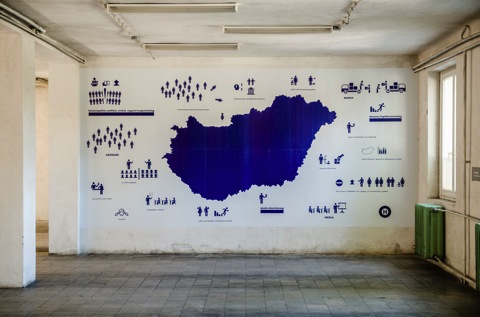
Albert, Ádám: The Counrty of the Blind, 504 x 238 cm, 2013
H.G. Wells: The Country of the Blind
The installation presents three basic institutions: school, work, and community. Its considers their current situation and role and examines topical issues in connection with them. Here and now 1. work means low rate of employment 2. community means economic, ethnic and political division and 3. school means lack of success and social mobility, a disadvantaged way of life. Depicting and presenting these three areas appears to be most suitable way of “describing” the conditions prevailing in Hungary in 2013.
Since the installation is neither based on network analysis nor attempts a visual representation of information based on statistics, the represented problems and their roots, which might be linked in various way, are situated in a “cloud of information” around the map of Hungary. Therefore, the picture can be read from any direction in several different way.
The title of the installation was borrowed from the title of a short story by H.G.Wells, “The country of the Blind” Although the title limits and constrains the interpretation of the work, the symbolic metaphors of the text create a playful interplay between these social messages with very obvious, sometimes even directly didactic meanings.
The giant poster (and the interior which was built around it as a quotation mark: the modernist sofa and coffee table) recalls the typical interiors of block of flats of the 70s and 80s: a picture of the tropics with palm trees or the snow-coverd mountain tops of the Alps. Feelings of (pseudo)familiarity are further reinforced by the table and the literary work lying on it. A tension is created between this (seemingly) “jovial”, “hurray-optimistic” picture and the distressing facts which are the reality of our everyday lives.
-------------------------------------------------
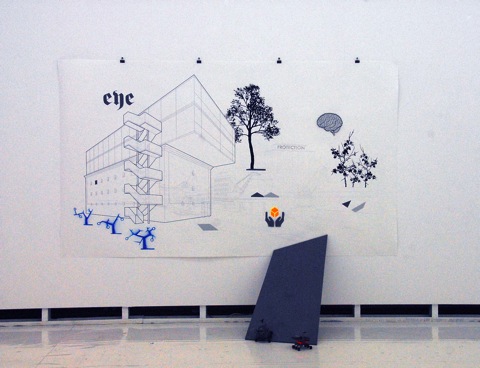
Albert, Ádám: o.T, installation, 2012
mixed media on paper, 270x157 cm, wood, plastic
ATELIERFRANKFURT e. V, Frankfurt am Main
-------------------------------------------------
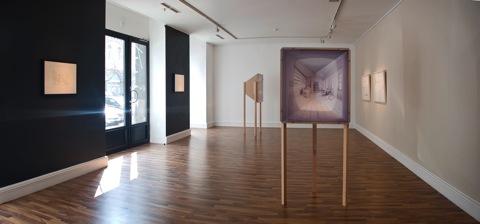
Albert, Ádám: Never take a trip alone, installation, 2011
This is a four part installation, consisting of two peep-shows, based on the technique of its 17th-century predecessor, two etchings, two 3D video simulations and two coloured drawings. The peep-shows depict two study rooms of two influential cultural figures of German history, Goethe and Alexander von Humboldt whereby it reflects on a wide scale of cultural-intellectual transmission throuh time placing them into an imaginary sphere of aesthetics.
The installation’s use of divergent technical apparatuses enhances that traversing through time is feasible through the juxtaposition of technical media from distant epochs, both those once of importance, like the perspective-box wich is now only referred as a unique but unimportant phase or dead-end of arthistory, and contemporary means of visualisation like 3D representation.
The 17th-century technical media appliance/invention thus traverses through time in this installation to appear renewed in the 21st-century with the help of artistic imagination as a form of artistic expression and plays with both, media and cultural history.
By considering also the changes of technical media, it confronts the viewer with how the different frameworks of contextualization can switch perspective: i.e. that historical dismissal of the perspective box from its aspiration to the status of high art made for the pleasure of highly educated and sophisticated collectors in the 17th century, and its aspiration to understand the mechanisms of depicting/visualization, as a children’s amusement in the 18-19th-century paradigm shift, when new forms of visual knowledge took its role, and the renewed artistic interest in the history of technical media with the emergence of new art. (Varga, Tünde)
Catalogue-text by Varga Tünde (PDF)
Contemporary Art in Hungary 2011/2012-text by Százados, László (PDF), ed. Spengler Katalin, Absolut Media
-------------------------------------------------

Albert, Ádám: Hunt the key - globalization and real estate in “the most emblematic Budapest street”
Social network vizualisation, 2010, 200 x 140 cm, enamel/iron plate
Running on the border of the 6th and 7th districts of Budapest, Király street was famously called in the past century “the most emblematic (Buda)Pest street” by they writer Gyula Krúdy. The neoclassical buildings on Király Street - some of them belonging to the national heritage list - now all await renovation or demolition. Amongst others, 25-29 Király Street, three nationally “protected” buildings adjacent to each other were for sale.
This visualization is based on 27 newspaper articles published since 2004 in 12 different papers, written by journalists committed to meticulous research on some of these processes and manipulations of the increasing globalization of Király Street. Analysis of the relationship of different companies, firms and people who were involved in one way or another in the procedure of selling these real-estate reveals a vastly complex network. The visualization displays people’s and companies’ affiliations differently, aiming to reveal a particular kind of power, decoding a convoluted, not at all transparent process which was applied in other 13 cases in the past 6 years along Király Street in Budapest.
The network analysis of King Street 25-29 reveals a pattern that served as a model for the privatization of several buildings in Budapest, which greatly contributed to the fact that the capital city lost part of its important architectural heritage without realizing and any profits, financial gains.
-------------------------------------------------
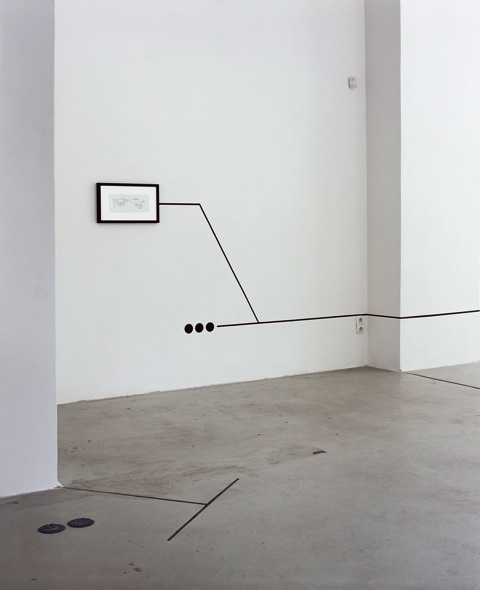
Albert, Ádám: installation, 2009
-------------------------------------------------
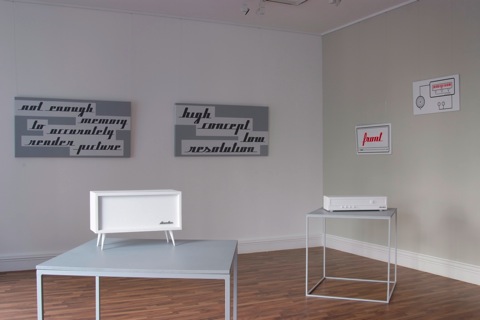
Albert, Ádám: decoder, installation, 2009
catalogue-text by Fenyvesi, Áron (PDF)
-------------------------------------------------

Albert, Ádám: Clockwork paradise, installation, 2007